7. Aboriginal and Torres Strait Islander mothers and babies
NSW Public Health Bulletin 21(1) 71-83 https://doi.org/10.1071/NB10S07
Published: 24 June 2010
Reporting of Aboriginality
Maternal Aboriginality is under-reported on the MDC. One method of assessing the extent of under-reporting and monitoring changes over time is to compare the reporting of maternal Aboriginality to the MDC with reporting of maternal Aboriginality on birth registrations held by the NSW Registry of Births, Deaths and Marriages. Using capture–recapture methods, an estimate of the total number of babies born to Aboriginal mothers was obtained and compared with the number of babies born to Aboriginal mothers as reported to the MDC (Table 67). An estimate of the total number of babies born to Aboriginal mothers or fathers was also obtained and compared with the number of babies born to Aboriginal mothers as reported to the MDC (Table 69). The method used here is described in Chapter 3 (p. 13).
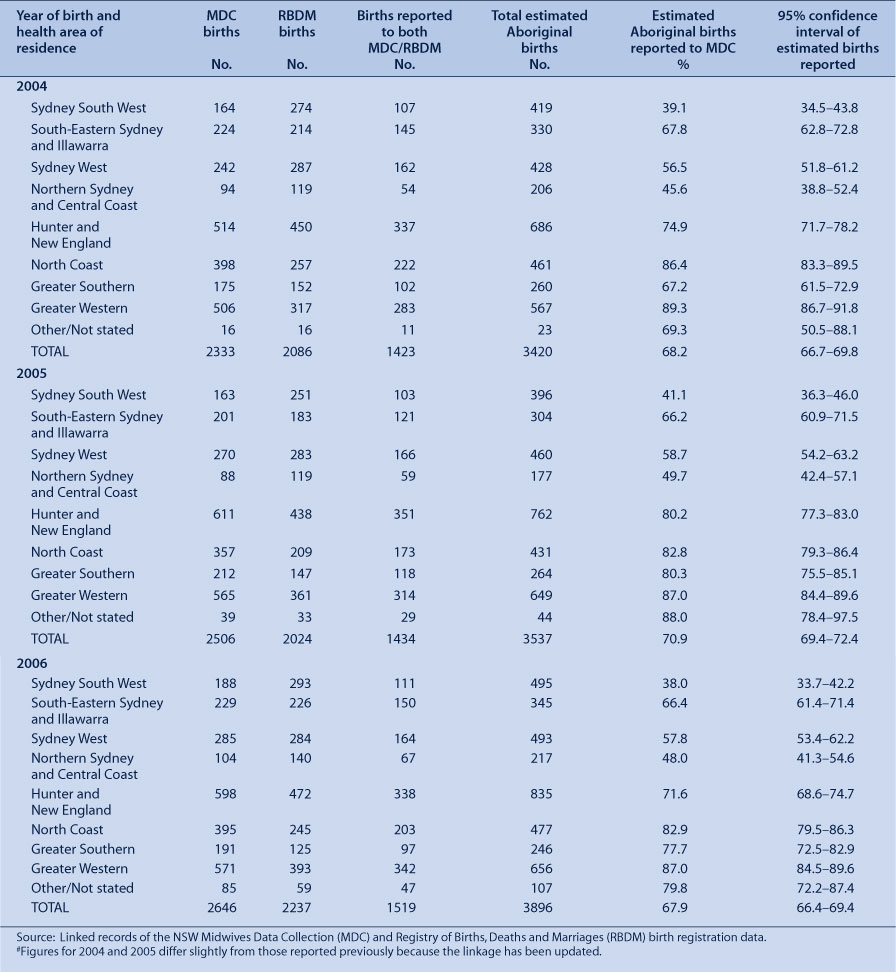
|

|
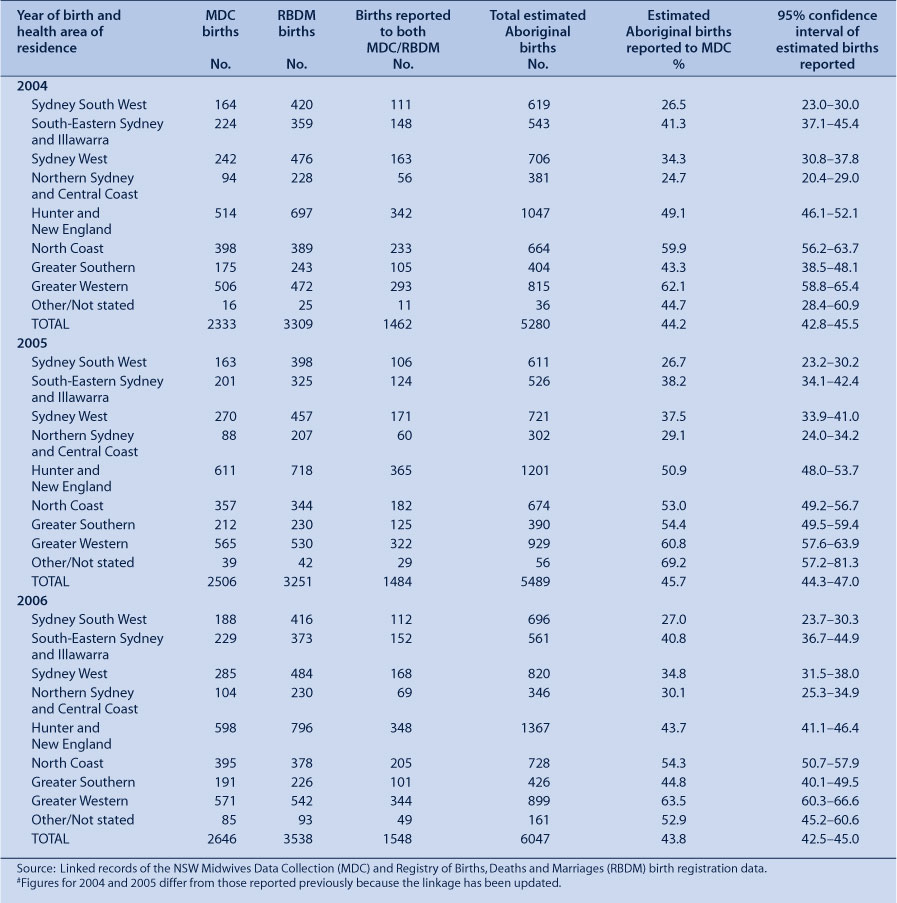
|
For NSW overall, the percentage of births to Aboriginal and Torres Strait Islander mothers reported to the MDC was stable at about 68–70% between 2004 and 2006. In 2006, reporting varied markedly among health areas, ranging from 38.0% in the Sydney South West Area to 87.0% in the Greater Western Area, with reporting generally better in rural than in urban areas (Table 67, Figure 2). Under-reporting of Aboriginality on the MDC means that numbers of births presented in this chapter should be interpreted with caution. The total number of babies born to Aboriginal mothers in 2006 is estimated to be 3896, about one and a half times higher than the number reported to the MDC.
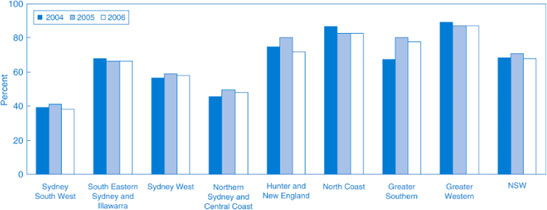
|
Information on paternal Aboriginality is not collected by the MDC, but is reported to the NSW Registry of Births, Deaths and Marriages. Of the 86 988 births registered for residents of NSW in 2006, 3508 (4.0%) were reported to have an Aboriginal or Torres Strait Islander mother or father (Table 68). For 1290 babies, the father was reported to be Aboriginal or Torres Strait Islander and either the mother was reported to be non-Aboriginal or Torres Strait Islander or the mother’s Aboriginality was not stated.
Table 69 shows the number of babies born to Aboriginal mothers as reported to the MDC and the number of babies born to Aboriginal mothers or fathers as reported to the NSW Registry of Births, Deaths and Marriages between 2004 and 2006. Using capture–recapture methods, an estimate of the total number of babies born to Aboriginal mothers or fathers was obtained from both data sources. For NSW overall, the percentage of births to Aboriginal and Torres Strait Islander mothers or fathers that were reported to the MDC was stable at about 44–46% between 2004 and 2006. In 2006, this percentage ranged from 27.0% in the Sydney South West Area to 63.5% in the Greater Western Area (Table 69). There are therefore a substantial number of babies with non-Aboriginal mothers and Aboriginal fathers who are not represented in the numbers reported in this chapter.
Trends in births
In 2007, 2736 babies were born to Aboriginal mothers, 54 babies were born to Torres Strait Islander mothers and 136 babies were born to mothers of both Aboriginal and Torres Strait Islander background (Table 70).
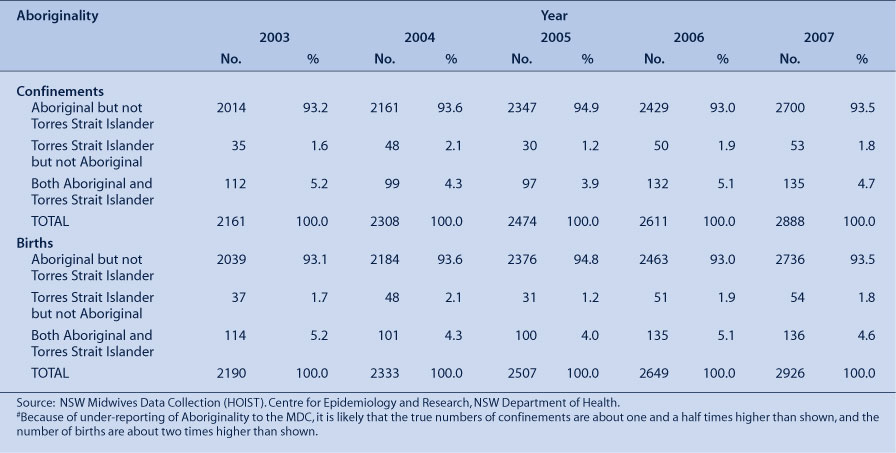
|
Plurality
Between 2003 and 2007, the reported number of babies born to Aboriginal and Torres Strait Islander mothers increased from 2190 to 2926 (Table 71), representing 2.5 and 3.0%, respectively, of all babies born in NSW. Multiple pregnancies (e.g. twins, triplets) were reported for about 1% of mothers.

|
Previous pregnancies
In 2007, one-third of Aboriginal and Torres Strait Islander mothers gave birth for the first time (Table 72), 58.3% of mothers reported between one and four previous births and 8.2% of mothers had given birth to five or more babies. This pattern has not changed substantially since 2003.

|
Maternal age
The percentage of Aboriginal and Torres Strait Islander mothers who were teenagers fell from 21.1% in 2003 to 18.8% in 2007. Following state-wide trends, the number of mothers giving birth at 35 years of age or more has increased during the last 5 years – from 153 in 2003 to 264 in 2007 (Table 73).

|
Health area of residence
The reported number of Aboriginal and Torres Strait Islander mothers has increased in all health areas between 2003 and 2007. The reported number of Aboriginal and Torres Strait Islander mothers who gave birth in 2007 ranged from 137 in the Northern Sydney and Central Coast Area to 655 in the Hunter and New England Area (Table 74). The proportion of mothers who were teenagers varied from 12.4% in the Northern Sydney and Central Coast Area to 21.9% in the North Coast Area (Table 75).
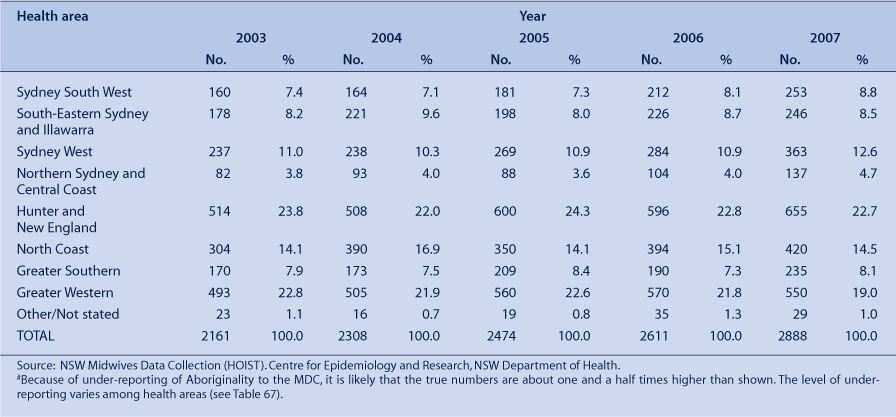
|
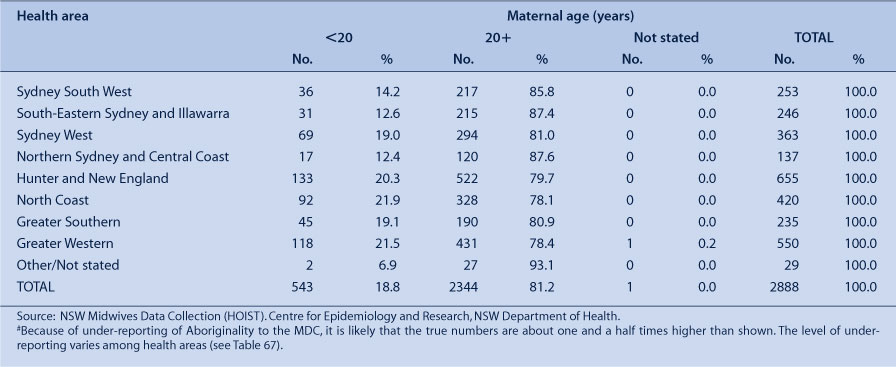
|
Duration of pregnancy at first antenatal visit
Between 2003 and 2007, the proportion of Aboriginal or Torres Strait Islander mothers who commenced antenatal care at less than 20 weeks gestation rose from 70.6 to 79.5% (Table 76). This compares with 91.1% of non-Aboriginal or Torres Strait Islander mothers who commenced antenatal care at less than 20 weeks gestation in 2007.

|
In 2007, the proportion of Aboriginal and Torres Strait Islander mothers who commenced antenatal care at less than 20 weeks gestation varied from 69.6% in the Sydney South West Area to 86.9% in the Northern Sydney and Central Coast Area (Table 77).

|
Smoking in pregnancy
In 2007, 50.1% of Aboriginal and Torres Strait Islander mothers reported smoking at some time during pregnancy, compared with 56.8% in 2003. This compares with 11.2% of non-Aboriginal or Torres Strait Islander mothers who reported smoking at some time during pregnancy in 2007.
Smoking in the second half of pregnancy poses the greatest risk to the health of both mother and baby. In 2007, 48.6% of Aboriginal and Torres Strait Islander mothers reported smoking in the second half of pregnancy. This percentage varied from 35.0% in the Northern Sydney and Central Coast Area to 54.2% in the Greater Western Area (Figure 3).
Medical conditions and obstetric complications
In 2007, there was a lower rate of gestational diabetes and pre-eclampsia reported among Aboriginal and Torres Strait Islander mothers than with non-Aboriginal or Torres Strait Islander mothers (Table 78). The number of Aboriginal and Torres Strait Islander mothers with medical conditions and obstetric complications reported to the MDC is low, even after taking into account under-reporting of maternal Aboriginality. This is particularly the case for diabetes. The low numbers may be due to under-detection and/or under-reporting.

|
Labour and birth
The rate of spontaneous onset of labour among Aboriginal and Torres Strait Islander mothers fell from 68.0% in 2003 to 65.2% in 2007 (Table 79), whereas the rate of induction of labour increased from 20.5 to 23.8%. The rate of induction of labour among Aboriginal and Torres Strait Islander mothers was slightly lower than the rate of 26.0% reported among non-Aboriginal and Torres Strait Islander mothers in 2007.

|
Between 2003 and 2007, the rate of normal vaginal birth fell from 73.3 to 69.8%. The caesarean section rate rose from 21.5 to 23.5% (Table 80). The rate of instrumental birth (forceps and vacuum extraction) rose slightly from 4.7 to 5.6%, and vaginal breech births contributed about 1% of all births.
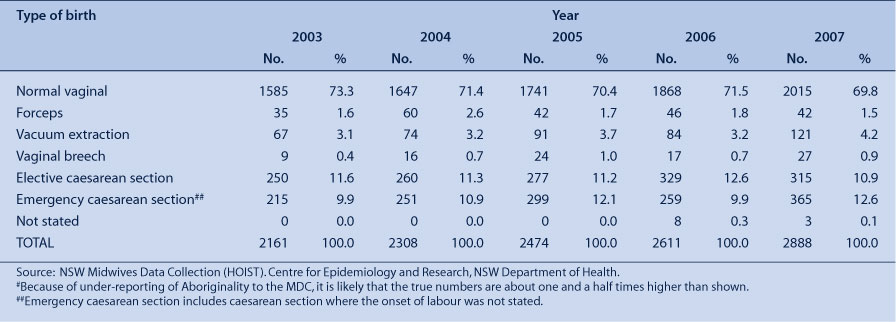
|
Birth weight
Since 2003, the rate of low birth weight (less than 2500 g) in Aboriginal and Torres Strait Islander babies has been over 10% and was 12.2% in 2007 (Table 81). This is about one and a half times the rate for babies born to non-Aboriginal or Torres Strait Islander mothers, which was 5.9% in 2007. In 2007, the largest number of low birth weight babies was born in the Hunter and New England Area (Table 82).

|
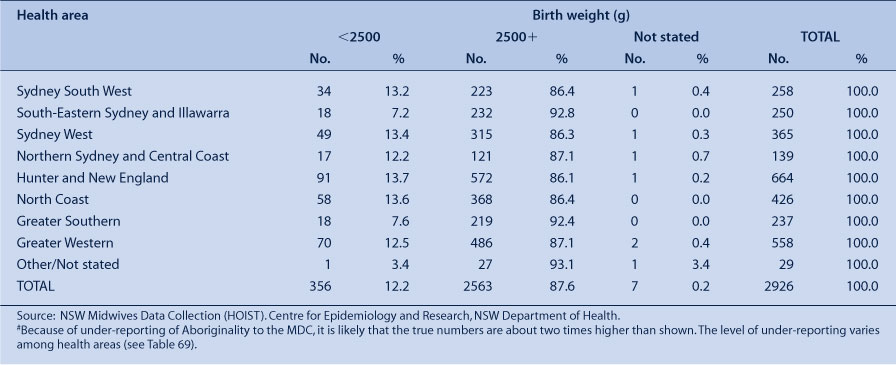
|
Gestational age
Since 2003, over 10% of Aboriginal and Torres Strait Islander babies have been premature (less than 37 weeks gestation) (Table 83). The rate of prematurity was 12.8% in 2007, compared with a rate of 7.2% for babies born to non-Aboriginal or Torres Strait Islander mothers. In 2007, the largest number of premature babies was born in the Hunter and New England Area (Table 84).

|
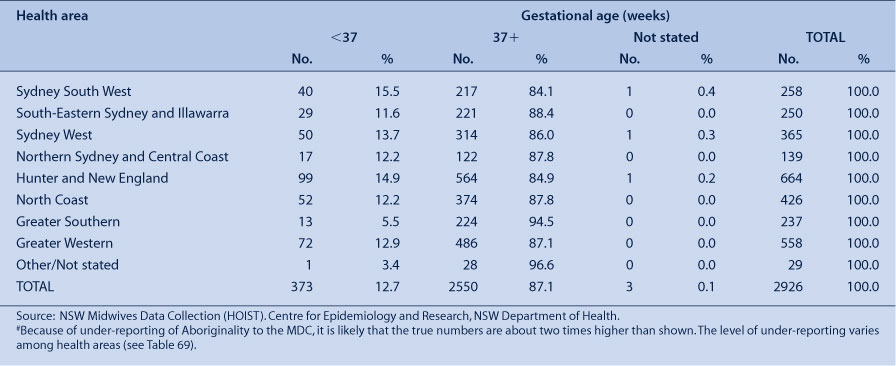
|
Apgar score
In 2007, 3.9% of Aboriginal and Torres Strait Islander babies had an Apgar score less than seven (Table 85), slightly higher than the rate of 2.0% for babies born to non-Aboriginal or Torres Strait Islander mothers.

|
Infant feeding
In 2007, 60.8% of babies born to Aboriginal and Torres Strait Islander mothers were fully breastfed, 4.4% were partially breastfed and 29.3% received infant formula only (Table 86). This compares with 78.8% of babies born to non-Aboriginal or Torres Strait Islander mothers who were fully breastfed in 2007. Rates of full breastfeeding ranged from 52.9% in Sydney West Area and Greater Western Area to 73.2% in the North Coast Area.
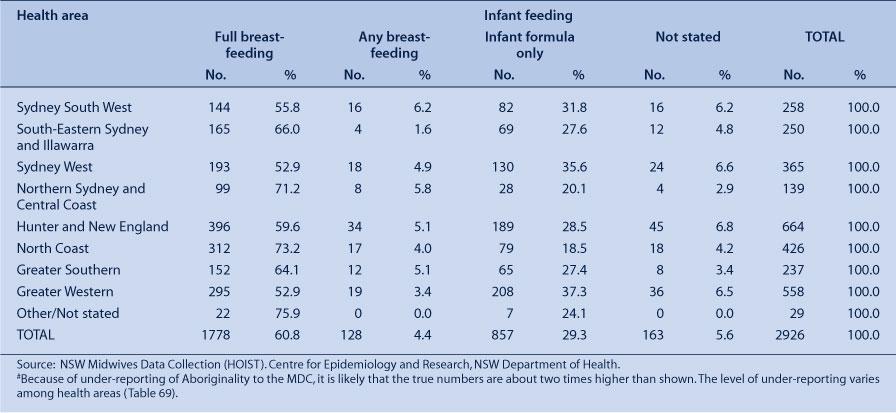
|
Perinatal mortality
Since 2007, the perinatal mortality rate among Aboriginal and Torres Strait Islander babies has varied from 11.6 to 22.6 per 1000 births (Table 87). The rate of 22.6 per 1000 in 2007 is substantially higher than the rate of 8.6 per 1000 experienced by babies born to non-Aboriginal or Torres Strait Islander mothers.

|



